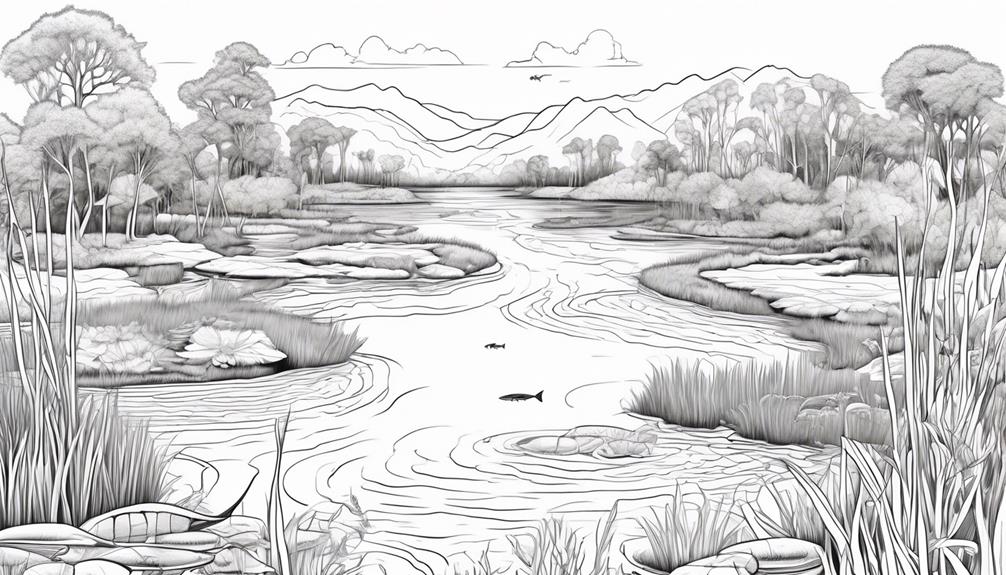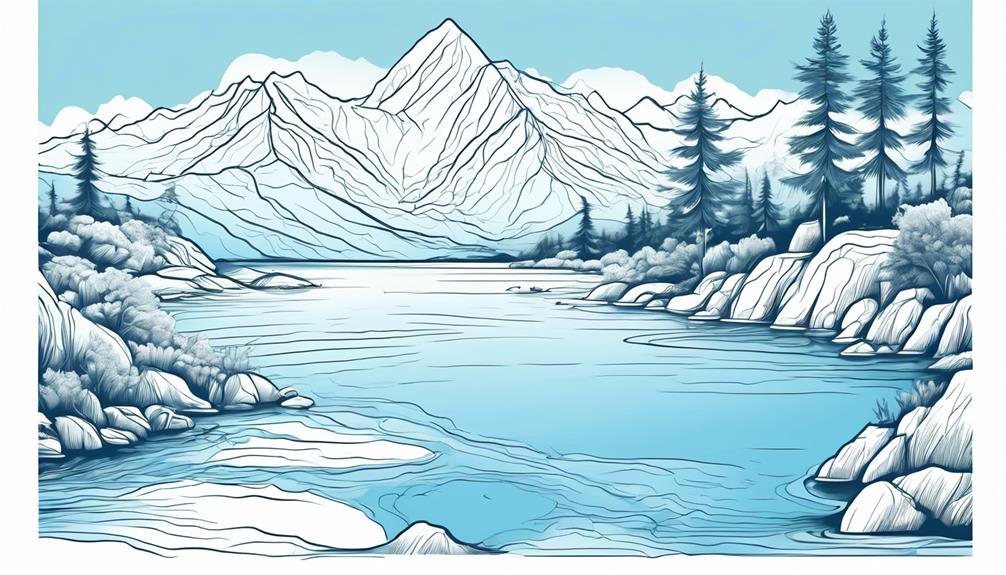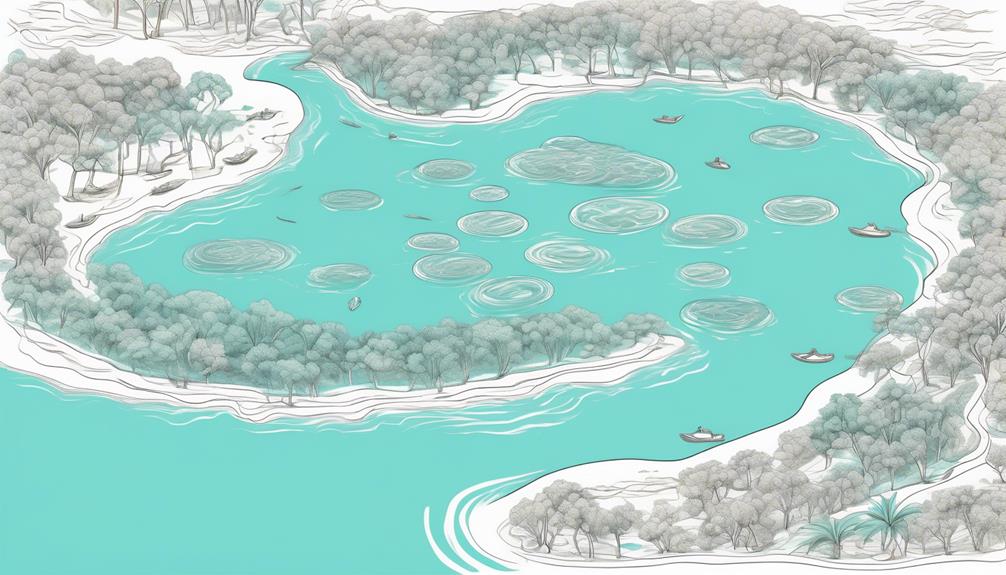Imagine stepping into a serene landscape, surrounded by the peaceful sound of flowing water. You find yourself standing on the banks of a crystal-clear lake, its surface shimmering under the gentle rays of the sun.
This is just one example of the countless freshwater bodies that exist around the world. From majestic rivers to tranquil ponds, these bodies of water hold a wealth of beauty and importance.
But have you ever wondered about the top 10 types of freshwater bodies globally? Join us as we dive into this fascinating topic, exploring the diverse habitats that support life and sustain our planet.
Get ready to embark on a journey through the wonders of lakes, rivers, ponds, and more, as we uncover the secrets held within these remarkable ecosystems.
Key Takeaways
- Lakes, rivers, ponds, and wetlands are natural freshwater bodies that support diverse ecosystems, provide habitats for wildlife, and play crucial roles in maintaining freshwater resources.
- Reservoirs are man-made freshwater bodies formed through damming of rivers or streams, serving as sources of drinking water, irrigation, and hydroelectric power generation. They have both positive and negative impacts on natural habitats and water quality.
- Springs are vital freshwater bodies with varying temperatures and mineral content, some of which have therapeutic properties. They are important for human communities and are among the top 10 freshwater bodies globally.
- Coastal freshwater bodies, such as lagoons, are shallow, coastal bodies of water separated from the ocean. They have tourism and cultural significance, serve as breeding grounds for marine species, and are vulnerable to human activities and climate change.
Lakes
Lakes, which are large bodies of freshwater surrounded by land, play a vital role in supporting diverse ecosystems and providing habitats for various wildlife species. They're one of the most common types of freshwater bodies found all around the world. Lakes can be formed naturally through geological processes such as tectonic activity or glacial melting. They can also be man-made, created by humans for various purposes like irrigation or water supply.
Some lakes are famous for their size, such as Lake Baikal in Siberia, which is the world's largest freshwater lake by volume. In North America, the Great Lakes are a group of interconnected lakes that form the largest freshwater system on Earth. Lake Victoria in Africa isn't only the largest lake on the continent but also the second-largest freshwater lake in the world.
Lakes support a wide range of ecosystems, providing habitats for fish, birds, and other wildlife. According to the United States Geological Survey, there are different types of lakes based on their characteristics, including glacial lakes, volcanic lakes, and oxbow lakes. These water bodies aren't only important for supporting biodiversity but also for human activities like fishing, boating, and recreational activities.
Rivers
Rivers, flowing with life-giving water from higher elevations to lower elevations, are indispensable sources of sustenance for countless ecosystems and communities. These dynamic bodies of surface water play a vital role in supporting a wide array of freshwater habitats and are essential to the overall health of our planet.
Rivers aren't only important for their role in the water cycle, but they also serve as crucial water resources for human societies. They provide us with drinking water, irrigation for agriculture, and water for industrial use. Throughout history, rivers have played a significant role in shaping human civilizations and cultures, serving as transportation routes and centers of trade and commerce.
However, rivers face numerous challenges, including water pollution. Due to human activities such as industrial waste disposal and agricultural runoff, rivers are often contaminated with pollutants that threaten the health of both ecosystems and human communities. It's essential for us to take responsibility for protecting and restoring the health of our rivers to ensure a sustainable future.
In addition to their critical role in providing water resources, rivers also support a rich biodiversity. They provide habitats for countless species of fish, amphibians, reptiles, and birds, contributing to the overall richness and complexity of freshwater ecosystems. Protecting and conserving these habitats is crucial for the survival of these species and the overall health of our planet.
Ponds
Are you curious about ponds? Well, let's dive into it!
Ponds come in all sizes, from tiny puddles to larger bodies of water. Despite their size, ponds play a vital role in the ecosystem. They provide a habitat for a wide variety of plants and animals, supporting a diverse array of life.
Size Variations of Ponds
Ponds come in various sizes, ranging from small, shallow depressions to expansive bodies of water covering several acres. The size of a pond can greatly influence its characteristics and the types of plant and animal species it supports.
Larger ponds, like Lake Baikal and Crater Lake, can provide habitat for a wider range of species, including fish, amphibians, and waterfowl. On the other hand, smaller ponds may have a more limited biodiversity.
The size of a pond also affects its water quality. Larger ponds tend to have more stable ecosystems and better water circulation, while smaller ponds may be more prone to fluctuations in temperature and oxygen levels.
Regardless of their size, ponds play important roles in supporting aquatic life cycles, serving as breeding and nursery areas for fish and as foraging and resting spots for migratory birds.
Ecological Importance of Ponds
As we dive deeper into the world of ponds, we uncover the ecological importance they hold in supporting diverse plant and animal species, contributing to the overall health and biodiversity of freshwater environments.
Ponds are crucial bodies of water in the context of the world's freshwater. They provide vital habitats for a wide range of creatures, such as frogs, turtles, and dragonflies, fostering a rich and diverse ecosystem.
Additionally, ponds play a significant role in maintaining water quality by filtering pollutants, which helps in preserving the overall health of freshwater environments. They also offer valuable resources for wildlife and serve as important breeding grounds for many species, making them essential for the survival of various organisms.
Therefore, the conservation and protection of ponds are vital for preserving the well-being of both ecosystems and human society, emphasizing their ecological significance.
Reservoirs
Reservoirs, the expansive man-made freshwater bodies formed through the damming of rivers or streams, serve a multitude of purposes and provide a wealth of recreational opportunities. These bodies of water are crucial for meeting our freshwater supply needs, especially in areas with limited natural sources of freshwater. Reservoirs not only store water for drinking and irrigation but also generate hydroelectric power to meet our energy demands.
To give you a better understanding of the importance and benefits of reservoirs, here is a table highlighting their various functions and advantages:
| Functions | Advantages |
|---|---|
| Drinking water supply | Provides clean, treated water to communities |
| Irrigation | Supports agricultural activities, ensuring food production |
| Hydroelectric power generation | Produces renewable energy, reducing reliance on fossil fuels |
| Recreation | Offers opportunities for boating, fishing, and swimming |
| Flood control | Minimizes the risk of downstream flooding during heavy rainfall or snowmelt |
However, it's important to note that reservoirs can also have environmental impacts. They can alter natural habitats, affect water quality, and disrupt river ecosystems. Additionally, reservoirs can contribute to groundwater pollution if not properly managed.
In a world facing a water crisis, reservoirs play a vital role in meeting our growing water demands. They provide us with a reliable and sustainable source of freshwater while offering recreational activities and flood control benefits. It is crucial that we continue to prioritize responsible reservoir management to ensure their long-term sustainability and minimize their negative impacts on the environment.
Wetlands

Now let's explore the fascinating world of wetlands, diverse ecosystems that offer a multitude of benefits and serve as vital habitats for a wide range of plant and animal species.
Wetlands, including marshes, swamps, bogs, and fens, play a crucial role in maintaining our freshwater resources. They act as natural filters, purifying water by trapping sediments, nutrients, and pollutants. This helps to improve water quality and protect the health of aquatic ecosystems.
In addition to their water purification function, wetlands also help to control floods. They absorb excess water during heavy rainfall, reducing the risk of downstream flooding. This makes them an important natural defense against extreme weather events.
Wetlands provide essential habitats for a variety of plant and animal species. They support a diverse range of vegetation, including water lilies, cattails, and reeds. These plants provide food and shelter for many wildlife species, including birds, amphibians, reptiles, and mammals.
One notable wetland area is Lake Superior, the largest freshwater lake in the world by surface area. It's surrounded by extensive wetlands that provide critical breeding grounds for waterfowl and support a variety of terrestrial mammals, such as moose and beavers.
In addition to their ecological importance, wetlands offer recreational opportunities for people to enjoy. Activities such as bird watching, fishing, and nature walks are popular among those seeking to connect with nature and appreciate the beauty of these unique ecosystems.
Springs
Nestled within the Earth's surface, springs emerge as natural sources of freshwater, providing essential sustenance for surrounding ecosystems and communities. These freshwater bodies are formed when underground water flows to the surface through a natural opening in the Earth's surface. Springs come in various forms, with each having its own unique characteristics and benefits.
Here are four key points to consider about springs globally:
- Temperature and Mineral Content: Springs can vary in temperature and mineral content, resulting in the formation of unique ecosystems around them. Some springs are hot, like the famous geothermal springs of Iceland, while others are cold and refreshing.
- Therapeutic Properties: Certain springs are renowned for their therapeutic properties. These healing waters have attracted visitors seeking wellness and relaxation for centuries. From the thermal springs of Bath in England to the mineral-rich springs of Pamukkale in Turkey, these destinations offer rejuvenation and healing.
- Ecosystem Support: Springs play a crucial role in supporting surrounding ecosystems. The constant flow of freshwater provides a habitat for diverse plant and animal species. These ecosystems rely on the consistent supply of freshwater from the springs to thrive.
- Human Dependence: Springs aren't only vital for ecosystems but also for human communities. Many civilizations have settled near springs throughout history, relying on their freshwater for drinking, agriculture, and other daily needs.
Springs are an integral part of the top 10 freshwater bodies globally, providing essential resources and creating unique environments for both nature and people to thrive.
Glacial Meltwater

As we shift our focus from springs, let's now explore the fascinating world of glacial meltwater and its impact on freshwater resources and landscapes worldwide.
Glacial meltwater refers to the water that's produced when glaciers and ice caps start to melt. This melting process releases vast amounts of water which contributes to the flow of rivers and streams. It plays a crucial role in providing freshwater resources to surrounding ecosystems.
However, glacial meltwater also has global implications. As the ice caps and ice sheets continue to melt due to climate change, the release of glacial meltwater can lead to an increase in global sea levels. Additionally, the water from glaciers often contains dissolved salts and solids, which can alter the salinity of surrounding bodies of water.
Glacial meltwater can also have dramatic effects on landscapes. The rapid release of this water can result in flash floods, as well as the formation of glacial lakes. These lakes can be temporary or long-lasting, and they shape the surrounding terrain through erosion and sediment transport.
Oxbow Lakes
Oxbow lakes, with their unique curved shape, play a crucial role in freshwater ecosystems and provide habitat for a diverse range of wildlife. Here are a few key points to help you understand the significance of these freshwater bodies:
- Oxbow lakes form when a U-shaped bend in a river becomes cut off from the main flow. This process creates a distinct curved lake that adds to the Earth's total freshwater.
- Due to their shape and placement within the landscape, oxbow lakes are home to a wide variety of wildlife. Fish, birds, and other aquatic organisms thrive in these habitats, contributing to the overall biodiversity of freshwater ecosystems.
- Oxbow lakes aren't just visually appealing; they offer recreational opportunities too. Many people enjoy fishing and birdwatching in these picturesque lakes, attracted by their tranquil waters and curved shorelines.
- Beyond their aesthetic and recreational value, oxbow lakes are essential for natural processes in river systems. They allow for sediment deposition and nutrient cycling, which are vital for maintaining the health of freshwater ecosystems.
Lagoons

With their unique characteristics and ecological importance, lagoons serve as another fascinating type of freshwater body that complements the significance of oxbow lakes. Lagoons are shallow, coastal bodies of water that are separated from the ocean by narrow barrier islands or reefs. They can be found in various locations worldwide, from tropical regions to temperate climates. Lagoons can be natural or man-made and offer diverse habitats for aquatic plants and animals.
These environments are valuable for tourism, providing opportunities for activities such as bird watching, kayaking, and snorkeling. Lagoons are often of cultural and ecological significance to local communities. They serve as important breeding grounds and nurseries for many marine species, offering shelter and feeding areas for fish, crustaceans, and birds.
Lagoons are vulnerable to human activities and climate change. They face threats such as pollution, habitat destruction, and alterations in water flow and salinity levels. The United Nations recognizes the importance of lagoons and has included them in their efforts to protect and conserve freshwater ecosystems.
In lagoons, the water can have varying salinity levels, ranging from brackish to freshwater. This creates unique conditions for different types of flora and fauna to thrive. Water lilies are often found in lagoons, adding beauty and color to these ecosystems.
Backwaters
Backwaters, located along the Arabian Sea coast of Kerala, India, form a captivating network of brackish lagoons and lakes that offer a unique and picturesque ecosystem. Here are some key facts about backwaters:
- Extending almost half the length of Kerala state, backwaters consist of five large lakes linked by canals, both man-made and natural. These waterways are fed by 38 rivers, creating a complex network of channels that meander through the lush green landscape.
- Known for their tranquil and scenic beauty, backwaters are a popular tourist attraction. Houseboat cruises along these serene waterways offer a relaxing and picturesque experience.
- The backwaters are home to a diverse range of flora and fauna. The brackish water supports unique species of aquatic life, making it a fascinating ecosystem to explore.
- Apart from their natural beauty, backwaters play a vital role in the local economy. They support fishing and agriculture activities, providing a source of livelihood for the communities living along the waterways.
- Additionally, these water channels serve as important transportation routes, connecting remote villages and allowing for the movement of goods and people.
Frequently Asked Questions
What Are the Main Bodies of Freshwater?
Freshwater bodies are essential for plants, animals, and humans. They support diverse ecosystems and provide resources for fishing, agriculture, and tourism. However, pollution and other threats endanger their quality. Conservation and sustainable management are crucial for their survival.
What Are the 5 Bodies of Freshwater?
There are various types of freshwater bodies, including rivers, lakes, ponds, wetlands, and streams. They are essential for sustaining life, supporting ecosystems, providing resources, and play a crucial role in water purification and flood control.
What Are the Largest Freshwater Bodies in the World?
The largest freshwater bodies in the world are crucial for freshwater conservation. They face threats from human activities that impact biodiversity and disrupt climate regulation. Conservation efforts are vital to protect these valuable resources.
What Are the 5 Main Freshwater Biomes?
Freshwater biomes, like lakes, rivers, and wetlands, are vital for ecosystems and biodiversity. They face threats like pollution and habitat destruction, caused by human activities. Conservation efforts are crucial to protect these ecosystems and maintain the global water cycle.
Conclusion
So, in conclusion, freshwater bodies are truly a treasure trove of life and resources. From the majestic lakes to the winding rivers, these habitats are home to a diverse array of plants and animals.
They not only provide essential resources for ecosystems but also support human society through activities like fishing and agriculture.
By protecting and conserving these precious habitats, we can ensure the well-being of our planet and all its inhabitants, for now and generations to come.
Freshwater bodies, the lifeblood of our world.
